20.03.2018
Media are invited to view NASA’s Interior Exploration using Seismic Investigations, Geodesy and Heat Transport (InSight) lander Friday, April 6, at Vandenberg Air Force Base in California, where it’s currently undergoing final tests for its May launch.
Media attending the event will have an opportunity to interview members of the InSight team and go into the cleanroom at Astrotech Space Operations to view the lander.
This event is open only to U.S. citizens who possess a government-issued photo identification, such as a driver's license, and proof of U.S. citizenship, such as a passport or birth certificate. Two forms of government-issued identification are required for access on the day of the event, including one with a photograph.
Media planning to attend this event must send their driver's license number and state of issue, date of birth, and name of their media outlet and editor's contact information, to 2nd Lt. Amy Rasmussen at amy.rasmussen@us.af.mil no later than noon PDT, Friday, March 30.
Due to space restrictions, only two representatives from each media outlet will be allowed to participate. More information will be provided to registered media regarding access, arrival and event times as details are finalized.
InSight will be the first mission to look deep beneath the Martian surface, studying the planet's interior by measuring its heat output and listening for marsquakes. It will use the seismic waves generated by marsquakes to develop a map of the planet’s deep interior. The resulting insight into Mars’ formation will help us better understand how other rocky planets, including Earth, are created.
InSight also will be the first planetary spacecraft to take off from the West Coast, launching aboard a United Launch Alliance Atlas V 401 rocket from Space Launch Complex-3 at Vandenberg. Currently scheduled for May 5, the two-hour launch window opens at 4:05 a.m. PDT (7:05 a.m. EDT).
NASA’s Jet Propulsion Laboratory in Pasadena, California, manages the InSight mission for the agency’s Science Mission Directorate. InSight is part of NASA's Discovery Program, managed by its Marshall Space Flight Center in Huntsville, Alabama. The spacecraft, including cruise stage and lander, was built and tested by Lockheed Martin Space in Denver. Several European partners, including France's space agency, the Centre National d'Étude Spatiales, and the German Aerospace Center, are supporting the mission. United Launch Alliance of Centennial, Colorado, is providing the Atlas V launch service. NASA’s Launch Services Program, based at its Kennedy Space Center in Florida, is responsible for launch management.
Quelle: NASA
---
Update: 24.03.2018
.
Atlas 5 rocket assembled for first Mars mission launch from Vandenberg
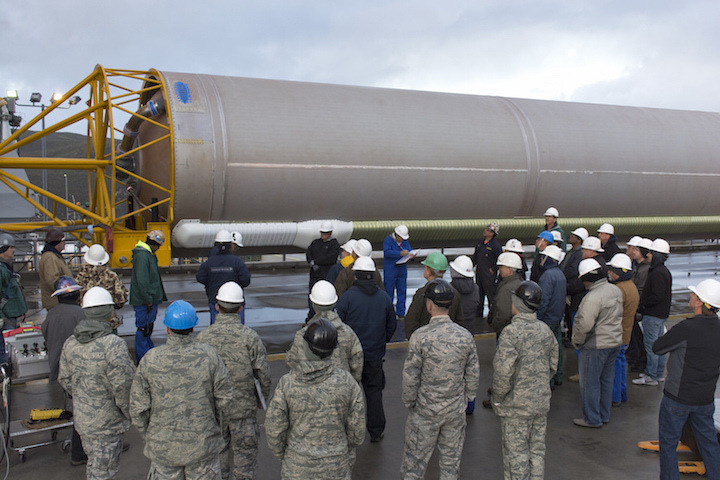
Ground crews at Vandenberg Air Force Base in California raised a United Launch Alliance Atlas 5 rocket on its launch pad earlier this month in preparation for liftoff May 5 with NASA’s InSight lander heading to Mars.
The two-stage rocket was assembled in three pieces, beginning with the stacking of the Atlas 5’s first stage booster March 3 at Space Launch Complex 3-East. The first stage’s RD-180 main engine will burn a mixture of kerosene and liquid oxygen to send the InSight spacecraft out of the Earth’s atmosphere during the first four minutes of the flight.
The Atlas 5’s Centaur upper stage, powered by an Aerojet Rocketdyne RL10 engine, was installed on top of the first stage March 6. The Centaur engine, consuming liquid hydrogen and liquid oxygen, will dispatch the InSight probe with enough velocity to escape Earth’s gravity and head for Mars.
Two days later, on March 8, a boattail structure was added to the top of the Centaur stage. The boattail provides an aerodynamic and structural connection between the Centaur and the Atlas 5’s payload fairing, which will be lifted on top of the rocket with the InSight spacecraft next month.
Liftoff is scheduled for May 5 during two-hour launch window that opens at 4:05 a.m. PDT (7:05 a.m. EDT; 1105 GMT). The InSight mission has until June 8 to depart Earth, a month-long period determined by the planetary positions of Earth and Mars in the solar system.
Built by Lockheed Martin, InSight will reach Mars on Nov. 26, using a heat shield, a supersonic parachute and retro-rockets to steer toward a soft touchdown on Elysium Planitia, a broad equatorial plain. Once on the ground, the lander will survey its surroundings with cameras, then use its robotic arm to place a seismometer instrument on the surface to listen for tremors that could provide clues about the red planet’s deep interior.
InSight will also drill into the Martian crust to a depth of nearly 16 feet, or 5 meters, to measure the heat coming up from the Martian interior. That is deeper than any previous Mars mission has scooped or drilled.
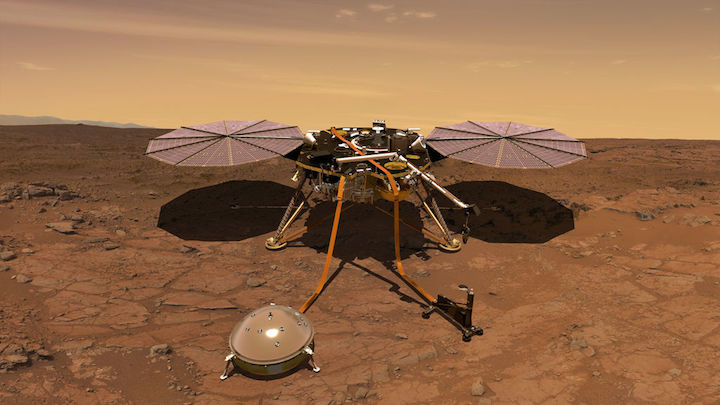
Scientists hope InSight will help them understand how rocky planets like Mars and Earth formed and evolved over the approximately 4.5 billion-year history of the solar system.
InSight will become the first mission to another planet launched from Vandenberg, the primary launch base on the U.S. West Coast. ULA and NASA officials agreed to launch InSight from California to alleviate demands on the launch schedule at Cape Canaveral, where around a half-dozen Atlas 5 missions are planned this year.
InSight will be the only Atlas 5 launch from Vandenberg in 2018, and the relatively light weight of the spacecraft is well within the Atlas 5’s lift capacity, eliminating the need to receive an extra boost of energy from Earth’s rotation by launching to the east from Florida’s Space Coast.
The launch of InSight will be the 78th flight of an Atlas 5 rocket since its debut in August 2002, and the 15th Atlas 5 mission from Vandenberg Air Force Base. InSight will be the fourth Mars mission to blast off atop an Atlas 5, after successful missions to send the Mars Reconnaissance Orbiter, the Curiosity rover and the MAVEN atmospheric research mission to the red planet.
InSight was originally supposed to launch in March 2016, but difficulties developing and testing the lander’s seismometer science instrument prompted officials to keep the mission grounded until 2018. Scientists say the seismometer problem has been resolved.
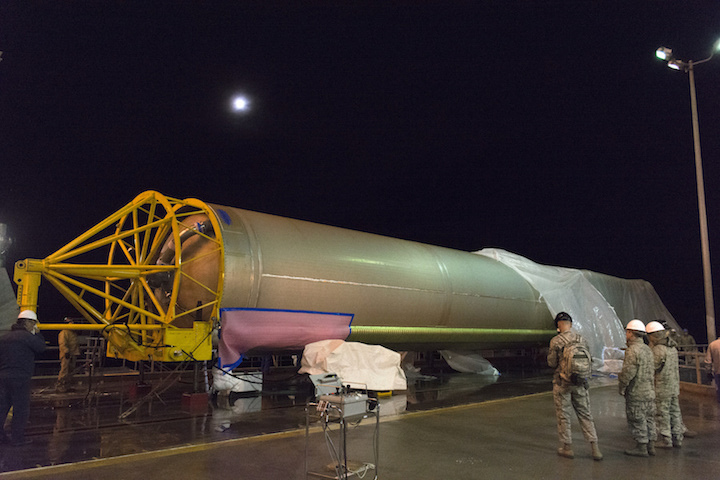
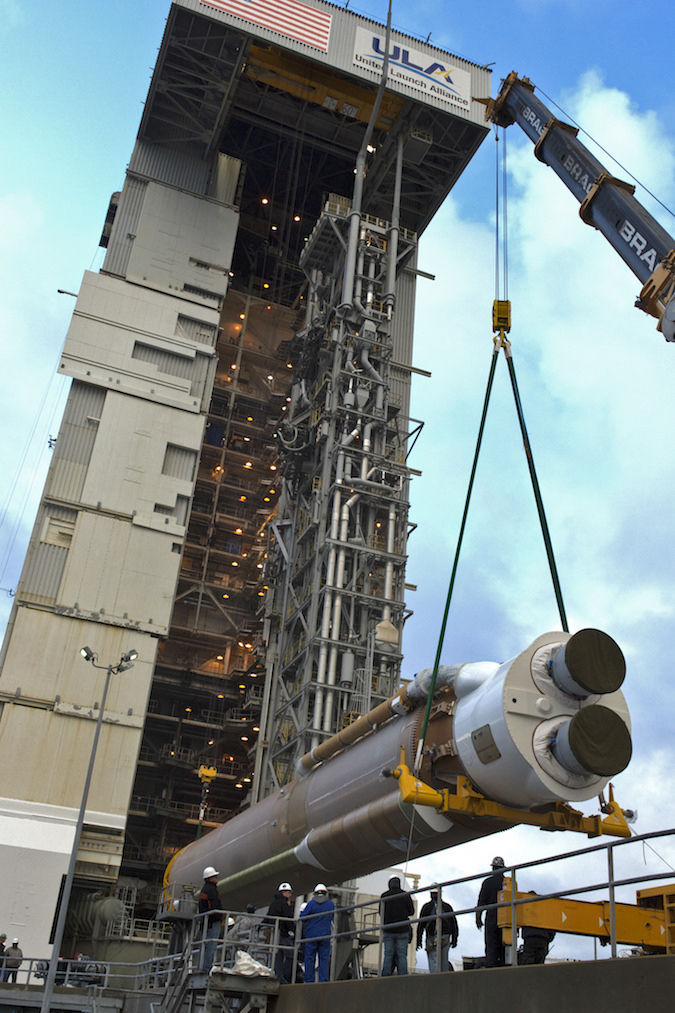
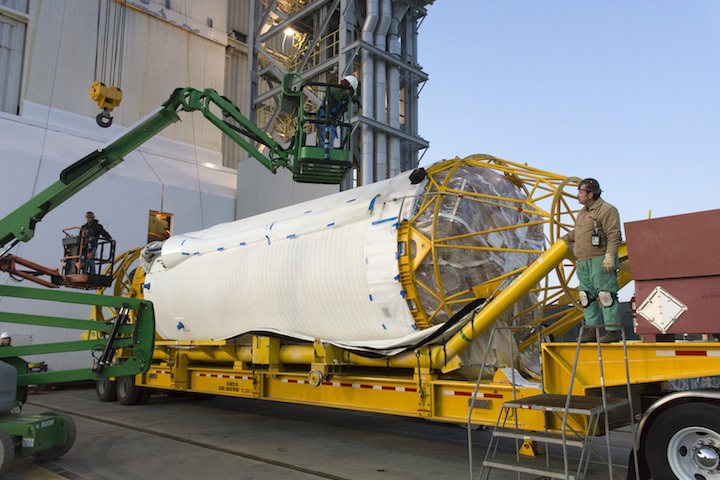
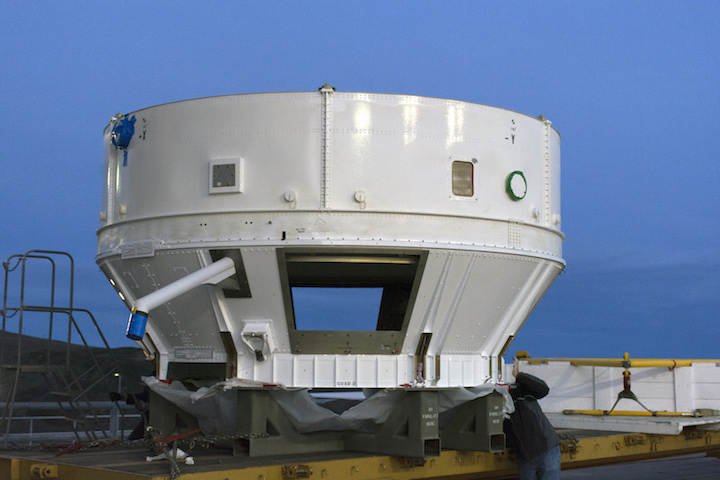
Quelle: SN
---
Update: 30.03.2018
.
NASA’s next mission to Mars will be California’s biggest launch ever
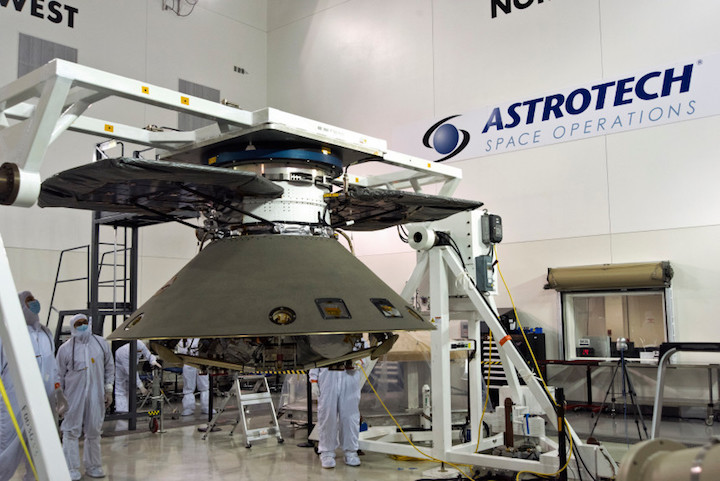
InSight is tested at the Astrotech processing facility at Vandenberg Air Force Base ahead of its scheduled May launch. (Credit: USAF 30th Space Wing/Alex Valdez)
-
When NASA’s next mission to Mars blasts off in May, it will become the first spacecraft launched from California to travel to another planet.
Project manager and California native Tom Hoffman jokes that he’s breaking up the East Coast’s monopoly on interplanetary launches.
But mostly, the Vandenberg Air Force Base in Santa Barbara County became the first choice because of how congested other launch sites, such as the Kennedy Space Center in Florida, have become in recent years.
“We have twice as many launches out of Kennedy as we do out of Vandenberg,” Hoffman said. “It allowed us to more easily get a 35-day launch period.”
InSight – Interior Exploration using Seismic Investigations, Geodesy and Head Transports – is a stationary lander that will study Mars’ interior, Martian earthquakes and how planets, including Earth, may have formed.
NASA will have two-hour launch windows every morning from May 5 to June 8, something that wouldn’t have been possible at Kennedy because of the number of other launches. Vandenberg is primarily used by satellites entering an orbit that circles the Earth’s poles, instead of a more common orbit that synchronizes with the planet’s rotation.
Historically, NASA’s Jet Propulsion Laboratory, based in La Canada Flintridge, has launched its robotic missions to Mars out of Cape Canaveral. Florida is ideal because the close proximity to the equator means NASA can take advantage of the Earth’s rotation to fling the rocket into space, Hoffman said.
InSight is able to launch from California because the Atlas V is much larger than the Delta II rockets used in older missions to Mars, Hoffman said. Those rockets, which are no longer in production, would not have enough energy to launch from Vandenberg.
“We have to fight the Earth more,” he said. “Most planetary launches have to go out of the East Coast because they don’t have all the excess capabilities that we have with the Atlas.”
Most of the team is expected to travel to Vandenberg to watch the launch. Typically, the launches from the East Coast are attended by essential personnel because of the cost, Hoffman said. InSight was originally supposed to launch in 2016, but it was delayed because of a leaky seal on one of the science instruments.

If the weather permits, the rocket’s ascent should be visible from Santa Maria to San Diego on May 5.
“It should be spectacular,” Hoffman said. “If you happen to be up with nothing better to do at four in the morning, just take a look out your back window.”
InSight is similar in design to 2008’s Phoenix lander. While Phoenix studied Mars’ habitability, InSight’s goal is to look deeper. It will carry instruments that can measure “Marsquakes,” the temperatures below the surface and the size of the planet’s core.
“In essence, it will take the vital signs of Mars, its pulse, its temperature and much more,” said Thomas Zurbuchen, NASA’s associate administrator for the science mission directorate. “We like to say its the first thorough check up since the planet formed four and a half billion years ago.”
The data collected about Mars’ interior will teach humanity about the formation of the Earth, our Moon and rocky planets in other solar systems, Zurbuchen said.
“This is more than just a Mars mission,” he said.
Mars is less geologically active than the Earth and has retained the fingerprints of the early processes that formed the planet, according to Bruce Banerdt, InSight’s principal investigator. One goal is to help planetary scientists understand how a “a ball of featureless rock” becomes a planet that may sustain life.
It’s instruments include a drill that will measure heat 16 feet beneath the surface and an extremely sensitive seismometer that can detect earthquakes on the opposite side of the planet. Unlike NASA’s rovers, these instruments require the spacecraft to stand still.
“We’re going to start getting the kind of detailed information about the inside of Mars that we’ve been waiting for for 40 to 50 years,” Banerdt said.
InSight will arrive at Mars in November, roughly six months after it leaves California.
It is expected to operate on the planet for at least 26 months – or one Martian year. Two microchips embedded on the spacecraft will carry the names of millions of fans who signed up ahead of the launch.
Quelle: Pasadena Star News
---
Update: 1.04.2018
.
NASA is Ready to Study the Heart of Mars
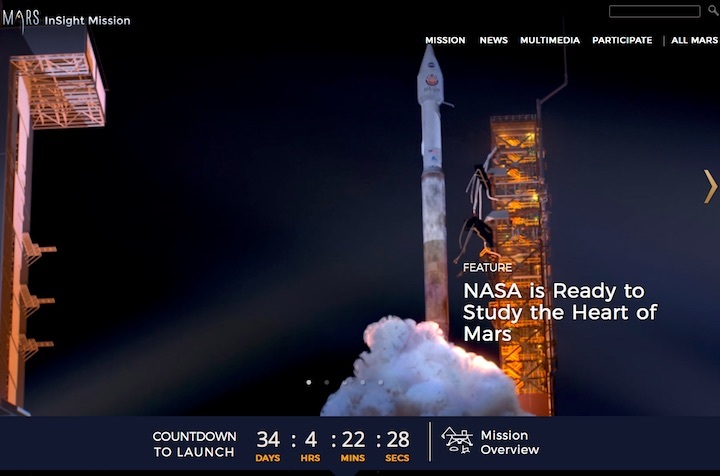
NASA is about to go on a journey to study the center of Mars.
The space agency held a news conference today at its Jet Propulsion Laboratory in Pasadena, California, detailing the next mission to the Red Planet.
NASA's next mission to Mars is weeks away from its May 2018 launch. InSight is more than a Mars mission. Its team members hope to unlock the mysteries of the formation and evolution of rocky planets, including Earth.
InSight -- short for Interior Exploration using Seismic Investigations, Geodesy and Heat Transport -- is a stationary lander scheduled to launch as early as May 5. It will be the first mission ever dedicated to Mars' deep interior, and the first NASA mission since the Apollo moon landings to place a seismometer on the soil of another planet.
For JPL's Bruce Banerdt, it's also a labor of love. Banerdt, InSight's principal investigator, has worked for more than 25 years to make the mission a reality.
"In some ways InSight is like a scientific time machine that will bring back information about the earliest stages of Mars' formation four-and-a-half billion years ago," Banerdt said. "It will help us learn how rocky bodies form, including Earth, its moon and even planets in other solar systems."
Scientists hope that by detecting marsquakes and other phenomena inside the planet, InSight can better understand how Mars formed. InSight carries a suite of sensitive instruments to gather these data; unlike a rover mission, they require a spacecraft that sits still and carefully places its instruments on the Martian surface.
NASA isn't the only agency excited about the mission. Several European partners contributed instruments, or instrument components, for the InSight mission. For example, France's Centre National d'Études Spatiales (CNES) led a multinational team that built an ultra-sensitive seismometer for detecting marsquakes. The German Aerospace Center (DLR) developed a thermal probe that can bury itself up to 16 feet (5 meters) underground and measure heat flowing from inside the planet.
"InSight is a truly international space mission," said Project Manager Tom Hoffman of JPL. "Our partners have delivered incredibly capable instruments that will make it possible to gather unique science after we land."
Looking deep into Mars will let scientists understand how different its crust, mantle and core are from their counterparts on Earth. In a sense, Mars is the exoplanet next door: a nearby example of how gas, dust and heat combine and arrange themselves into a planet.
InSight is currently at Vandenberg Air Force Base in California undergoing final preparation before launch. On Wednesday, it completed what's known as a spin test: the entire spacecraft is rotated at high speeds to confirm its center of gravity.
That's critical for its entry, descent and landing on Mars in November, Hoffman said. In the next month, the spacecraft will be mounted to its rocket, connections between them will be checked, and the launch team will go through a final training.
"This next month will be exciting," Banerdt said. "We've got some final work to do, but we're almost ready to go to Mars."
JPL, a division of Caltech in Pasadena, California, manages the InSight Project for NASA's Science Mission Directorate, Washington. Lockheed Martin Space, Denver, built and tested the spacecraft. InSight is part of NASA's Discovery Program, which is managed by NASA's Marshall Space Flight Center in Huntsville, Alabama.
Quelle: NASA
---
Update: 10.04.2018
.
In the early morning hours of May 5, millions of Californians will have an opportunity to witness a sight they have never seen before – the historic first interplanetary launch from America’s West Coast. On board the 189-foot-tall (57.3-meter) United Launch Alliance Atlas V rocket will be NASA’s InSight spacecraft, destined for the Elysium Planitia region located in Mars’ northern hemisphere. The May 5 launch window for the InSight mission opens at 4:05 am PDT (7:05 EDT, 11:05 UTC) and remains open for two hours.
“If you live in Southern California and the weather is right, you’ll probably have a better view of the launch than I will,” said Tom Hoffman, project manager for NASA’s InSight mission from the Jet Propulsion Laboratory in Pasadena, California. “I’ll be stuck inside a control room looking at monitors -- which is not the best way to enjoy an Atlas 5 on its way to Mars.”
In clear skies, the InSight launch should be viewable up and down a wide swath of the California coast. Residents from as far north as Bakersfield to perhaps as far south as Rosarito, Mexico, may see the Atlas rocket rising in the predawn sky and then heading south, parallel to the coastline.
The United Launch Alliance two-stage Atlas V 401 launch vehicle will produce 860,200 pounds (3.8 million newtons) of thrust as it climbs away from its launch pad at Vandenberg Air Force Base, near Lompoc, California. During the first 17 seconds of powered flight, the Atlas V will climb vertically above its launch pad. Then it will begin a pitch and yaw maneuver that will place it on a trajectory towards Earth’s south pole.
“After lift-off from Vandenberg’s Space Launch Complex 3, the Atlas V begins a southerly trajectory and climbs out over the Channel Islands off Oxnard,” said Tim Dunn, launch director for the Launch Services Program at the John F. Kennedy Space Center in Florida. “If you live on the California Central Coast or south to L.A. and San Diego, be sure to get up early on May 5th, because Atlas V is the gold standard in launch vehicles and it can put on a great show.”
Mach One occurs 1 minute and 18 seconds into the Atlas V’s powered flight. At that time the vehicle will be about 30,000 feet (9 kilometers) in altitude and 1 mile (1.75 kilometers) down range. Two minutes and 36 seconds later, the Atlas first stage will shut down at an altitude of about 66 miles (106 kilometers) and 184 miles (296 kilometers) down range. The Centaur second stage (carrying InSight inside a 40-foot-long payload fairing) separates from the now-dead first stage six seconds later. Ten seconds later, the Centaur’s engine kicks in with its 22,890 pounds (101,820 newtons) of thrust, which will carry it and InSight into its 115-mile-high (185-kilometer) parking orbit 13 minutes and 16 seconds after launch. This parking orbit will last 59 to 66 minutes, depending on the date and time of the launch. The Centaur will then re-ignite for one last burn at one hour and 19 minutes after launch, placing InSight into a Mars-bound interplanetary trajectory. Spacecraft separation from the Centaur will occur about 93 minutes after liftoff for the first May 5 launch opportunity as the spacecraft is approximately over the Alaska-Yukon region.
InSight's launch period is May 5 through June 8, 2018, with multiple launch opportunities over windows of approximately two hours each date. Launch opportunities are set five minutes apart during each date's window.
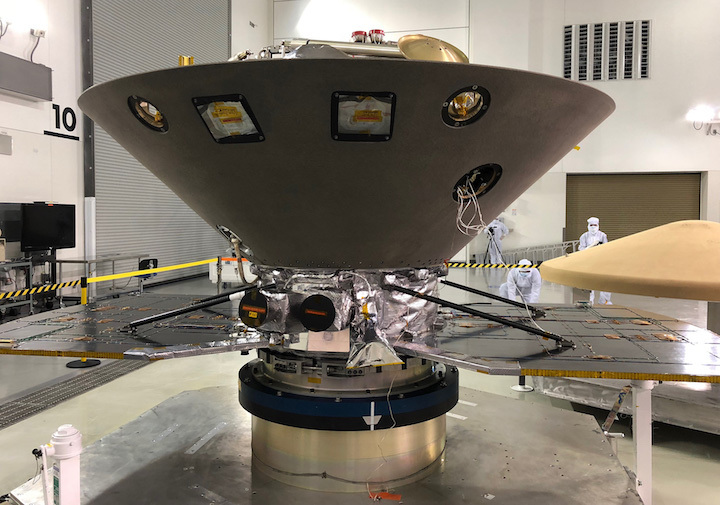
InSight Mars lander joined with Atlas 5 launcher at Vandenberg Air Force Base
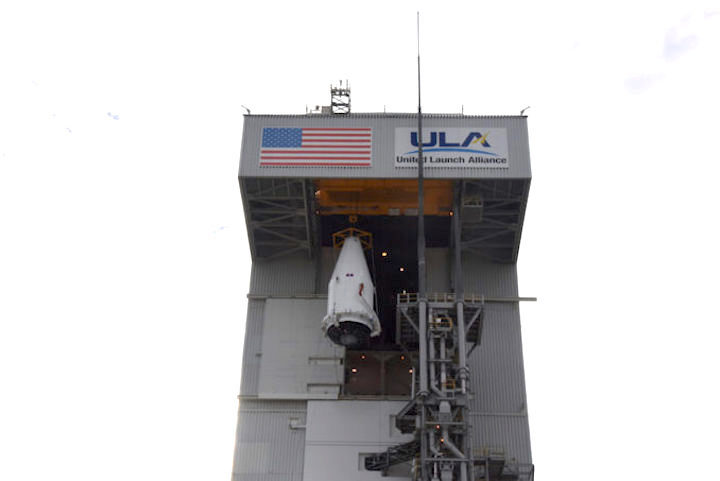
Ground crews at Vandenberg Air Force Base on California’s Central Coast hoisted NASA’s InSight Mars lander atop a United Launch Alliance Atlas 5 rocket Monday, kicking off nearly two weeks of integrated tests and checkouts before the probe’s interplanetary launch window opens May 5.
Enclosed within the Atlas 5’s metallic 13.8-foot (4.2-meter) diameter shroud, the InSight spacecraft was transferred from an Astrotech payload processing facility to Space Launch Complex 3-East at Vandenberg early Monday. A crane lifted the probe top the Atlas 5 rocket protected inside the launch pad’s mobile gantry, and technicians mated the payload on top of the Atlas 5’s Centaur upper stage.
With the addition of InSight and its aerodynamic enclosure, the Atlas 5 rocket stands 188 feet (57 meters) tall.
No photos of payload lift operation were released by NASA or ULA as of Tuesday afternoon.
The final assembly of the Atlas 5 rocket is one of the last major steps before launch. Engineers will check electrical connections between the launcher and its payload in a series of tests over the next few days, setting up for final readiness reviews next week and the start of countdown preparations the evening of Friday, May 4, with the retraction of the mobile service tower at the SLC-3E launch pad.
InSight has a two-hour launch predawn window May 5 opening at 4:05 a.m. PDT (7:05 a.m. EDT; 1105 GMT). The nearly $1 billion mission, funded primarily by NASA with contributions from France and Germany, has until June 8 to launch from Vandenberg, when the ever-changing positions of Earth and Mars in the solar system make a direct trip possible. Mars launch opportunities come once every 26 months.
The lander will arrive at Mars on Nov. 26, regardless of the launch date from May 5 through June 8.

InSight will be the first mission to another planet to launch from Vandenberg, a military base on the Pacific coast between Los Angeles and San Francisco.
Vandenberg Air Force Base is typically host to launches into polar orbit, a type of orbit usually tailored for climate research missions, spy satellites and some communication applications.
NASA’s interplanetary probes are usually reserved for launches from Cape Canaveral, where rockets take off toward the east over the Atlantic Ocean for safety reasons. A launch toward the east gains an extra boost from the speed of Earth’s rotation, allowing a rocket to carry a heavier payload.
But InSight is small — it will weigh around 1,530 pounds (694 kilograms) at launch — well below the lift capability of the United Launch Alliance Atlas 5 rocket, which will fly in its basic “401” configuration with a four-meter payload fairing and no solid rocket boosters.
That means the Atlas 5 will not need the extra energy imparted during an eastward launch from Cape Canaveral, and ULA and NASA agreed to launch InSight from Vandenberg. Fewer Atlas 5 missions are scheduled from Vandenberg, so officials wanted to reduce the workload at ULA’s busier launch base in Florida.
“We’re really excited,” said Lt. Col. Kenneth Decker, commander of the 4th Space Launch Squadron at Vandenberg, in an interview with Spaceflight Now earlier this year. “Since it’s not a classified mission and it’s more public, it’s fun for our squadron because we can interact a little more and share information with our families and other people.”
The 4th Space Launch Squadron provides support for ULA’s Atlas and Delta rocket missions at Vandenberg, a launch manifest that is primarily comprised of secret spy satellites for the U.S. government.
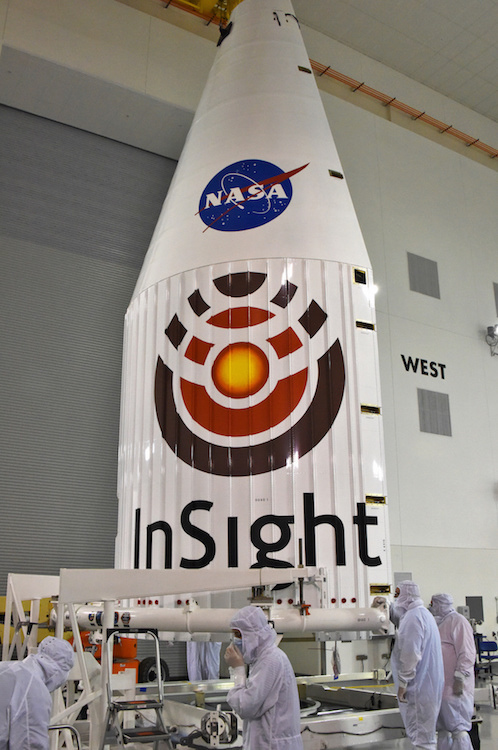
Designers based the InSight lander on NASA’s Phoenix probe, which launched in August 2007 and touched down on the northern polar plains of Mars in May 2008. Diminishing solar power and cold temperatures limited Phoenix’s lifetime to about five months — two months longer than its three-month prime mission.
InSight will head for a broad plain near the Martian equator with ample sunlight year-round. Officials selected the landing site in Elysium Planitia for its safety — there are few steep slopes or huge boulders. Bruce Banerdt, InSight’s principal investigator at NASA’s Jet Propulsion Laboratory, calls it “the biggest parking lot on Mars.”
A robotic arm on InSight will place a French-built seismometer on the surface of Mars near the lander, and a heat probe provided by the German space agency, DLR, will burrow up to 16 feet (5 meters) underground to measure thermal energy coming from the red planet’s interior.
Scientists will collect the seismic and thermal data to find out about the structure of Mars’s crust, mantle and core. The information will help geologists understand how rocky planets like Mars, and Earth, formed in the early solar system.
The geologic record dating back to the birth of the planets some 4.5 billion years ago has been erased on Earth.
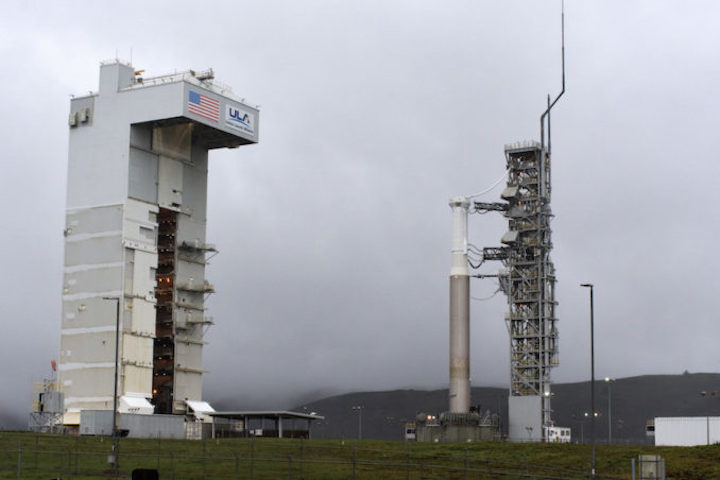
ULA’s launch team at Vandenberg began assembling the Atlas 5 rocket on its launch pad at Vandenberg on March 3 with the stacking of the kerosene-fueled first stage booster.
The Atlas 5’s Centaur upper stage, powered by an Aerojet Rocketdyne RL10 engine, was installed on top of the first stage March 6. The Centaur engine, consuming liquid hydrogen and liquid oxygen, will dispatch the InSight probe with enough velocity to escape Earth’s gravity and head for Mars.
Two days later, on March 8, a boattail structure was added to the top of the Centaur stage. The boattail provides an aerodynamic and structural connection between the Centaur and the Atlas 5’s payload fairing.
A pair of CubeSats that will accompany InSight to Mars were installed on their carrier aboard the Centaur upper stage last month. The CubeSats will fly by Mars and attempt to beam telemetry from InSight back to Earth during the lander’s descent.
The launch team completed a countdown rehearsal March 22, during which the Atlas 5 was loaded with liquid propellants to simulate launch day procedures. The “wet dress rehearsal” is not part of a typical Atlas 5 launch campaign, but managers added the test to wring out any potential problems with the rocket well ahead of liftoff due to InSight’s tight interplanetary launch period.
Quelle: SN















